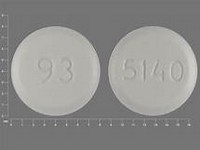mexiletine hydrochloride

CLINICAL USE
Ventricular arrhythmias, especially after a myocardial infarctionDOSE IN NORMAL RENAL FUNCTION
Oral: 400 mg loading dose, followed by 200–250 mg 3–4 times daily commencing 2 hours after the loading doseIV injection: 100–250 mg at a rate of 25 mg/minute with ECG monitoring, followed by an infusion of 250 mg as a 0.1% solution over 1 hour, 125 mg/hour for 2 hours then 500 micrograms/minute thereafterPHARMACOKINETICS
DOSE IN RENAL IMPAIRMENT
GFR (mL/MIN)
DOSE IN PATIENTS UNDERGOING RENAL REPLACEMENT THERAPIES
IMPORTANT DRUG INTERACTIONS
Potentially hazardous interactions with other drugsADMINISTRATION
Reconstition
–Route
IV infusion
, oralRate of Administration
VariableComments
Add 250–500 mg mexiletine to 500 mL of infusion solution, e.g. sodium chloride 0.9%, glucose 5%, sodium bicarbonate 8.4%, sodium lactate, sodium chloride 0.9% with potassium chloride 0.3% or 0.6%OTHER INFORMATION
Mexiletine has a narrow therapeutic index. Its therapeutic effect has been correlated with plasma concentrations of 0. 5–2 micrograms per mLMexiletine is metabolised in the liver and is excreted in the urine, mainly in the form of metabolitesRate of elimination increased with acidic urineInjection can be given orally; however, due to local anaesthetic effect, care needed with hot foods
See how to identify renal failure stages according to GFR calculation
See how to diagnose irreversible renal disease
Home








